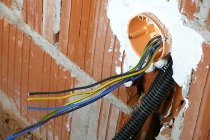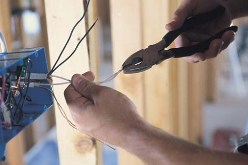Categories: Sharing experience, Electrician Secrets, Electrician at home
Number of views: 383273
Comments on the article: 24
Tips of an experienced electrician - replacing and installing electrical wiring in an apartment
In this article we will analyze in detail all the subtleties of the process of the device in the apartment of the new wiring. This work can be successfully carried out independently. Indeed, in commercial organizations, for example, Gorkomservice, the prices for installing electrical wiring in an apartment bite. And an average of about 650 rubles per square meter of total area.
Cable brand selection
1. Each core of the wire must be rigid (single core), because all sockets and switch are designed for installation with a hard wire.
2. The choice of brand of occasion. Three types of wire are mainly used: NYM, VVG, PUNP.
NYM cable is a cable with copper single-wire conductors with reliable triple insulation.
The first layer is PVC, the second layer is a rubber sheath, the third is each copper core in PVC. But this wire is not without flaws. It is not recommended to be placed in raw concrete and carried out outdoors, it has a large diameter and is quite expensive.
But, if you do wiring in the apartment and want something more reliable, then take, of course NYM.
VVG cable - a cable with copper single-core conductive conductors, with insulation from PVC plastic - value for money. It has double insulation: common PVC and each core in PVC.
VVG can be laid anywhere: both on the street and in concrete. Isolation is slightly worse than NYM, but better than PUNP.
If you do not need extra expenses, we select the simplest and most commonly used PUNP wire for domestic purposes. It has double insulation: 1st PVC common; 2 each lived in PVC. His insulation is thinner than that of NYM and VVG, but also not bad. If we take the PUNP of the Moscow plant, then its insulation will be thicker than that of other manufacturers.
Now we select the cross section of the wire, and the number of cores. According to the existing standard, the wire must be three-wire. The usual color combination of wire strands: zero - blue, phase - white, earth - yellow-green. The wire cross section for outlets is 2.5 mm2, for lighting - 1.5 mm2, and for an electric stove - 4 mm2.
See more about this here:Which wire is best for house wiring
Circuit Breaker Selection
Consider selection of circuit breakers three manufacturers - ABB, LEGRAND and DEC.
In ABB machines, all conductors inside and clamps outside are copper, which improves contact with the wire and reduces heat. The circuit breaker trips when the network is overloaded several milliseconds faster than the DEC.
In LEGRAND automation, the conductors inside and the clamping contacts outside are copper-plated. They are also of good quality and are on a par with ABB.
In DEK electric machines, metal clamping contacts. They work fine, provided that they are native. The shutdown is a bit slower than ABB and LEGRAND.
Electricity in the apartment must be reliable. The security of your home depends on it. Any automation must be taken in special stores, such as: "ELECTRICAL INSTALLATION", "CABLE-WIRE", etc., where they can confirm the quality of the product. This will eliminate the fake. Automation in the market can cost more and be of dubious quality.
All wiring in 8 minutes:
Purchase of material for electrical installation of an apartment
1. This is a drawing on the plan of the apartment of places where sockets, switches, lamps, a TV, a telephone, a dishwasher, etc. will be installed In short, everything related to electrics.
2. We consider the number of individual power lines. For example: a two-room apartment is a stove, a washing machine, kitchen sockets 1, kitchen sockets 2, first room sockets, second room sockets, water heater, light. A total of 8 separate power lines. From this number of lines, we consider the footage of the electric wire and the number of automatic machines.
If the apartment is small, 60 sq.m., then the approximate amount of electric wire is as follows -
electric stove - 15-20 meters VVG - 3 * 4mm2,
sockets - 100 meters VVG- 3 * 2.5 mm2,
light - 100 meters VVG - 3 * 1.5 mm2.
From the calculation of 8 groups, we buy automation. To the light - 16 A, to the stove - 32 A, to the water heater (storage) - 16 A, to all other sockets 25 A.
Plus, an introductory two-pole automatic machine at 50 A and a common RCD at 63A and 30 μa leakage current. You can put differential machines or RCDs in groups, but this is a more expensive option).
We also need to -
television wire RG-6 - 50 meters,
telephone wire (preferably 4-wire) - 40 meters,
electric sockets - 40 pcs. (plastic with mounting points on four sides),
screws 35 mm - 0.5 kg,
dowels - 200 pcs. (for fixing wires) ,,
soldered electrical boxes - 6 pcs. (for branching wires),
corrugated pipe - 100 meters (conduct wires in it if they go under a plasterboard ceiling or under a floor screed.),
alabaster - 20 kg (for the smearing of rosette and partial putty coating),
electrical tape - 6 pcs.
How to arrange sockets and switches
Usually sockets are located at a height of 25 cm from the floor (middle of the socket). Switches - 80-90 cm from the floor. Kitchen outlets are located on a tile apron, at a height of 1 m from the floor ..
Outlets in the bathroom must be waterproof and located at least 1 m from the floor, which is dictated by safety requirements.
The places of sockets and switches and their number are determined from the convenience - does not block the furniture, platbands and baseboards do not interfere with installation, the wire from the appliance reaches the outlet, each appliance has its own outlet (it is better to do without a tee so safer).
Shtroblenie walls and flows in concrete and brick apartments under the hidden wiring
Strobing is hard, noisy and dusty work. Especially if you are chipping concrete. It is necessary to ditch not only the grooves for the wires, but also the recesses for the sockets and the niche for the shield. Therefore, before strobing, carefully consider the direction of the strob in order to reduce their length as much as possible, but at the same time do not forget that all strobes should go strictly at right angles. This is both professional and beautiful, and the most important thing is to see where and where the wire sticking out of the wall comes from (less likely to interrupt or drill it).
To save money, if we have sockets on one wall on both sides, we make a plug on one side of the wall, and drill a hole for the other side. As a result, we only got one strobe on two sides of the wall. We also come with the upper light for chandeliers, etc.
In order to gouge the walls you need a hammer drill, the power of which depends on the strength of the walls, and a grinder with a diamond disk. If the conditions allow, the apartment is not residential, it will turn out faster if you saw through all the intended strobes with a grinder with a diamond disk or shtroborezom, and then hollow out the rest with a puncher.
But this is too dusty work and you need to work in all protective equipment (respirator, glasses, gloves, headphones, although many work without the last 3). If there are no conditions or you do not like a large amount of dust, you can do the same work with just one puncher.
It is easier to hammer a perforator at the joints of plates (two walls, a ceiling and a wall, 2 ceiling), because as a rule, they are covered with a light cement mixture.
Strobing can be done with a spatula or a special shtrobnik, but they, as a rule, quickly become dull, as they do not have a solid winning layer at the end. The best option is to perform shtrobleniye drill diameter of 12-14 mm. Its winning tip is quite difficult to blunt, and it costs less than a scapula and a shtrobnik.
The recesses under the sockets are drilled with a special crown (for gypsum or brick) or, if the wall is concrete, it will be faster to do it with the same drill. To do this, draw sizes of wall sockets, we drill with a drill around the perimeter and inside the marking of the hole with a depth slightly more than the depth of the undergrowth, set the puncher to the position of only hollowing and with the same drill we cut out all the excess inside the mark.
See also on this topic: Rules for installing hidden electrical wiring in the home
Wiring electrical and low-current (TV, telephone, Internet, speakers) wires.
 All electrical wires are from electrical panel to the locations of sockets or soldered boxes, from them again to sockets or soldered boxes, etc.
All electrical wires are from electrical panel to the locations of sockets or soldered boxes, from them again to sockets or soldered boxes, etc.
All low-current wires are from the low-precision staircase to each individual point in the apartment.
The wire is mounted in the strobes using dowels and brackets with self-tapping screws.
It is better to lead the electric wire to the light on the ceiling in corrugated pipe (if there is a suspended plasterboard ceiling), if there is no suspended ceiling, then in the strob at the junction of the ceiling and the wall to the place of the electric soldered box (as a rule, it is 15 cm from the ceiling and located above the switch), from it to the chandelier at the junction of ceiling plates etc. in all rooms.
The electric wire to the outlet group and low-current wires should be led along the floor along the walls in separate corrugated pipes (if it is possible to remove the corrugated pipe under the cement floor screed), if not, then in the strobe at the level of the outlets to their location.
Tip for sticking a wall into a wall
We insert electrodetectors into the recesses, start the wires in them and stir the alabaster, after wetting the recess with water. We smear the undergrowths with alabaster, so that they do not protrude from the wall.
Well, that’s probably all.
I wish you success in the field of electrical installation.
Skalin Eugene
See also at e.imadeself.com
:

